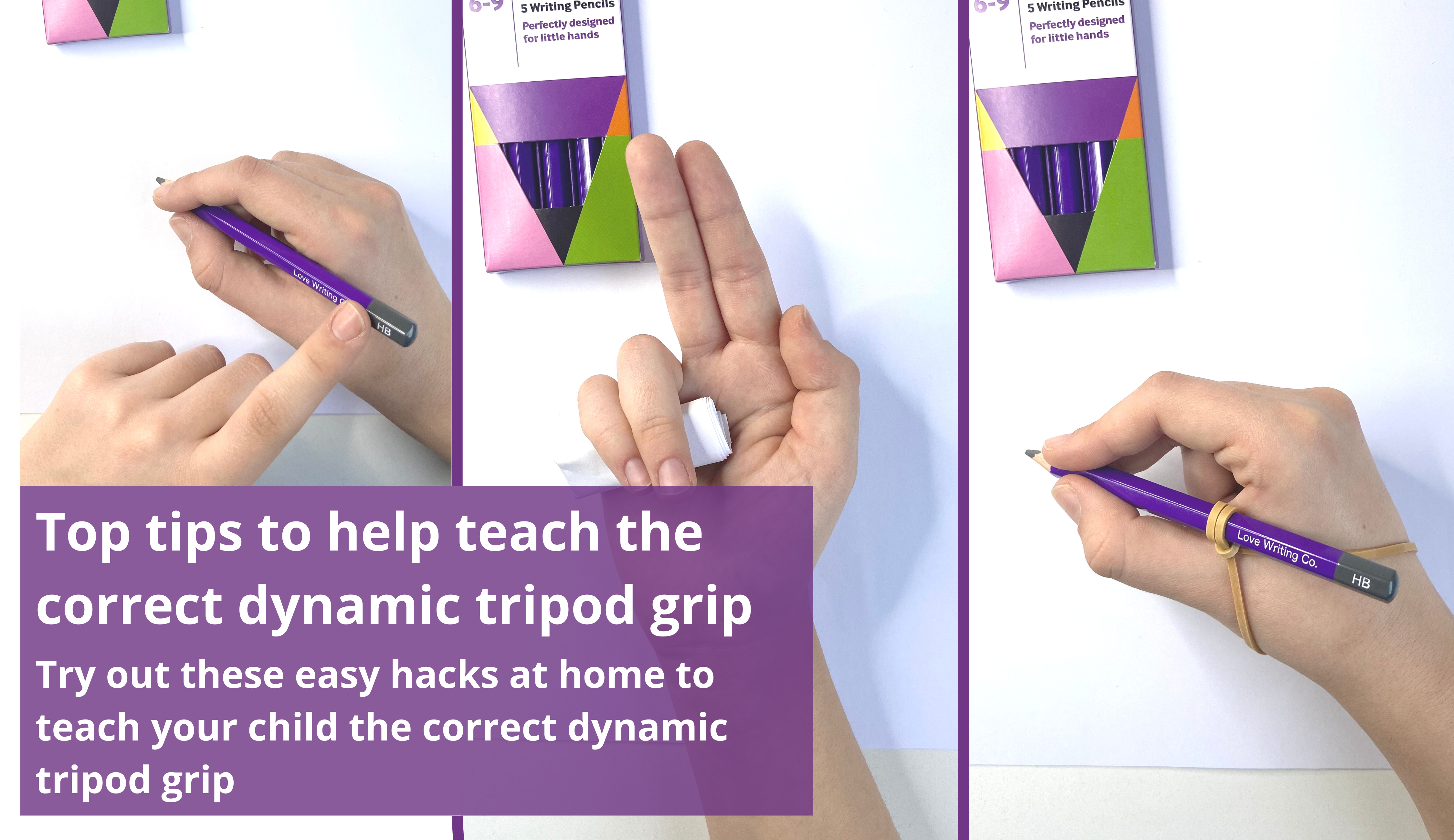It’s so exciting when our children become curious about learning to write their name for the first time!
We’re here to help you take the first steps and make your child’s learning to write experience easy, quick and fun from the very start.
For your child (and for you as a parent also), writing their own name for the first time is such an important milestone in their life. It helps them to understand and engage with not only those crucial sounds and letters of the alphabet, but also boosts their confidence and gives them a sense of individuality.
We have tons of fun amazing activity ideas, crafts and hacks for you to try with your little learner to help them enjoy writing their name and make the process easier!
In this blog we'll be diving into:
- The importance of learning to write your name in early years
- What we can do to make it easier for our children to write their names
- 10 super easy & fun Name writing hacks, tips & crafts to try out to boost their name writing ability
- Our Top Pick resources that will help them write their letters and names easier
- Access to help and resources: FREE Printable handwriting letter practice worksheets to help children write their name
Why is learning to write your name so important?
The importance of your child learning to read and write their own name goes without saying - they will use these skills for the rest of their lives. Learning to write your name creates such a great sense of accomplishment for your little learner. It shows that practice makes perfect and demonstrates that when we are determined and keep trying - anything is possible!
To write your own name proudly builds identity and gives a sense of individualism. It's a great way to teach children about who they are, all of their great qualities and that their name is an amazing part of their identity. It's always a great idea to tie in learning topics such as self-love & uniqueness when learning about writing your name.
For your child to write their name, they must first learn formation of letters A-Z as well as engage with the phonic sounds that comes with them. When a child learns to spell their name, they use the sounds as well as letters to sound it out.
Practicing letter recognition is the first basic step to teaching your child how to read and write their name. Why's learning the alphabet and forming letters so great, I hear you say? Well, it's because learning to write means that a children can then read. For your child to know how to spell their own names, they must know how it sounds first.
Another important thing to bare in mind when teaching your child to write their name is repetition. Now, what we mean by this is practicing multiple times and doing this often. The more they practice, the easier it will be - but it doesn't have to be so boring. For example, you can ask them to write their name at the top of the shopping list - anywhere you get an opportunity for them to practice, encourage it!
Tracing or copying their name multiple times will also significantly improve your child's hand-eye co-ordination as well a developing fine motor skills and building pencil grip & control strength.
How can I make it easier for my child to learn to write?
1. Make teaching your child to write their own name quicker, easier and fun with our Love Writing Co. Learn to Write & Draw the Alphabet Book!
2. Teach your child everyone's name.
Start by asking them to repeat after you. Say everyone's name whilst pointing towards them. Afterwards ask your child ‘’What is your name?’’ and ‘’Who am I?’’. Learning to write your own name is easier when we can confidently say it and sound it out loud.
3. Using name tags everywhere.
For example, on their books, clothes and cups - this gives children a sense of belonging as well as a learning aid. Plus, you'll never lose anything so it's a win-win!
4. Encourage your child to write their own cards for occasions.
Have your child send out birthday invitations or thank you cards to friends and family with their name signed at the bottom. Giving your child important tasks makes them feel valued, boosts their self-esteem and are likely to focus on the task at hand.
5. Use Workbooks with various shaped pencil control activities.
When practicing pencil control, focus on using swirls, shapes and zigzags will help children improve fine motor skills and form different letters like w,v,x,z.
All of our Handwriting practice workbooks have dedicated pencil control pages and lots of hand strength building for children aged 3-9.
Shop the top handwriting workbooks for children here - click here.
10 Super Easy Must Try Name Writing Activities For Children: Early Learning Expert Advice
- Flash cards
Help your child learn to spell their name using fun and colourful flashcards. Let your child not only practice pencil control through creating, designing and colouring their own flashcards, but also allow them to then position them in the right order. You could make lots of different shapes, sizes and colours - the opportunities are endless!
We have created pencil flashcards to match our Love Writing Co. Tripod Grip Writing Pencils which you can buy now - the perfect MUST-HAVE writing pencils for children to help them adopt the correct Tripod Grip. Shop writing tools to help children write easier here.
Simply use the two ends to help children to learn and understand where the start & beginning is as well as the the first, last and middle letters of their names.
- Salt painting
Try this easy and cost effective name writing craft activity for kids! Trace out your child's name using some PVA glue and sprinkle a layer of salt over the top. Then, gently pour the excess salt away.
Afterwards use our 3-in-1 chunky colouring crayons for children that have 3 uses: watercolour, crayon & pastels! Use the vivid & bright watercolours to carefully paint onto the salt - the salt absorbs the colours and creates a fun, colourful and beautiful design!
For the best results, use our 3-in-1 Washable Arty Crayons that are designed to aid Fine motor skills, tripod grip and build hand-muscle as well as unleash your child's inner artist. PLUS they're washable - super easy clean crayons, it's a win-win!
- Sticker name tracing
Write out your little one's name on some paper nice and big. Then, have them trace their name by sticking stickers along the lines. Because let's be honest, what kid doesn’t LOVE stickers?
Peeling stickers is an amazing fine motor skills activity to help strengthen little ones fingers and hand muscles. Using our pincer grasp to peel and stick stickers is great tripod pencil grip practice.
Top Tip: Use Love Writing Co. Handwriting Practice Books help to improve letter and word formation, extend phonics knowledge and build pencil control PLUS 36 fun reward stickers for a job well done! Shop all workbooks for ages 3-9 here.
Did you know? All of our lay-flat workbooks ideal for right and left-handed children compliment the UK National curriculum and we are proud to say our resources are also endorsed by The British Dyslexia Association and SEN Friendly.
Click here to shop Ages 3-9: Pre-cursive and Cursive Handwriting & Alphabet Practice Workbooks now!
- Sensory Tray
Use anything at home like sand, salt or shaving foam to create a sensory tray! Using crushed up cereal is a great idea because it's sweet, yummy and safe to eat! Make a thin layer of this in your sensory tray and have your child trace letters and shapes with their fingers. All you have to do is shake the tray to start again each and every time.
- Lego brick names
Write each letter of your child's name onto a lego brick. Have them build up the bricks to spell out their name. Not only does this familiarise your child with the letters in their name but playing with building blocks helps to strengthen the muscles in our hands.
- Crayon transfer art
Perfect using our 3-in-1 Washable Arty Fine Motor Crayons for kids with three creative uses; crayons, watercolours and pastels. Colour in an entire sheet of paper using a rainbow of different colour crayons. Then, place your sheet of paper (crayon side facing down) over a fresh sheet of paper. Grab a writing pencil and on the back write and draw to your heart's content! Once finished you should be left with some beautiful rainbow crayon transfer art!
- Playdough names
Firstly, write your child's name in bubble writing. Then have them mould some playdough into the shape of each letter of their name. This activity is fantastic for early learners as it helps with letter and word formation but also improves the core strength in our hands, wrists and arms!
- Pavement chalk
Use pavement chalk to create a hopscotch or an obstacle course combining your child's name. Each letter could indicate an activity or exercise. Or incorporate your child's name into a hopscotch and have them spell out a letter of their name for every hop!
Using pavement chalk and playing outside not only builds our fine AND gross motor skills (which are both essential when learning to write), but also improves physical and mental health too.
Top learning resources and learning aids to help your child write their name & letters easier: Including product links
Before a child can form letters they need to be able to hold their pencil comfortably and confidently.
Pencil grip and control activities help children to build fine motor skills and improve hand eye coordination.
Fun tracing and colouring activities encourages a love for learning and boosts creativity!

For early learners, our top pick to Build confidence and practice your pre-writing skills is with My First Pencil Control Activity Workbook with 16 pages of fun, engaging pencil control and handwriting downloadable worksheet book.
Click here to shop our Fun Printable Packs now! Available in ages 3-9
Visit our website at www.lovewritingco.com to discover more children's handwriting resources
FREE resources to help your child write their name - DOWNLOAD TODAY! Worksheets, activities and handwriting guides
Improve fine motor skills through cutting and sticking craft activities and learn letter formation and build pencil grip and control through tracing, colouring and drawing activities
With a large variety of free downloadables to choose from, as well as 3 FREE Handwriting guides including:
- Phonics guide including a bonus FREE phonics chart
- Left-handed early learner writing guide
- Handwriting tips & tricks guide
Head to www.lovewritingco.com and sign up as an exclusive newsletter subscriber to gain access to all of your free worksheets, parent community, advice, tips & tricks and more.
Well that's all from us, thank you for reading! We hope you take some inspiration from these ideas and find this blog helpful in teaching your child to write their name for the first time.

Remember to snap, tag and share with us all your amazing crafts and name-writing practice @lovewritingco - We would love to see! Happy name-writing!
If you liked this one you should check this article out too! ⬇️
How to help your child develop correct tripod grip. Read Here:
https://lovewritingco.com/blogs/blog/how-to-help-your-child-develop-the-correct-dynamic-tripod-grip






















1 comment
vasan City Acadamey
Your guide on teaching children to write their names is practical and helpful. Thanks for empowering parents with valuable strategies.
Leave a comment
All comments are moderated before being published.
This site is protected by hCaptcha and the hCaptcha Privacy Policy and Terms of Service apply.